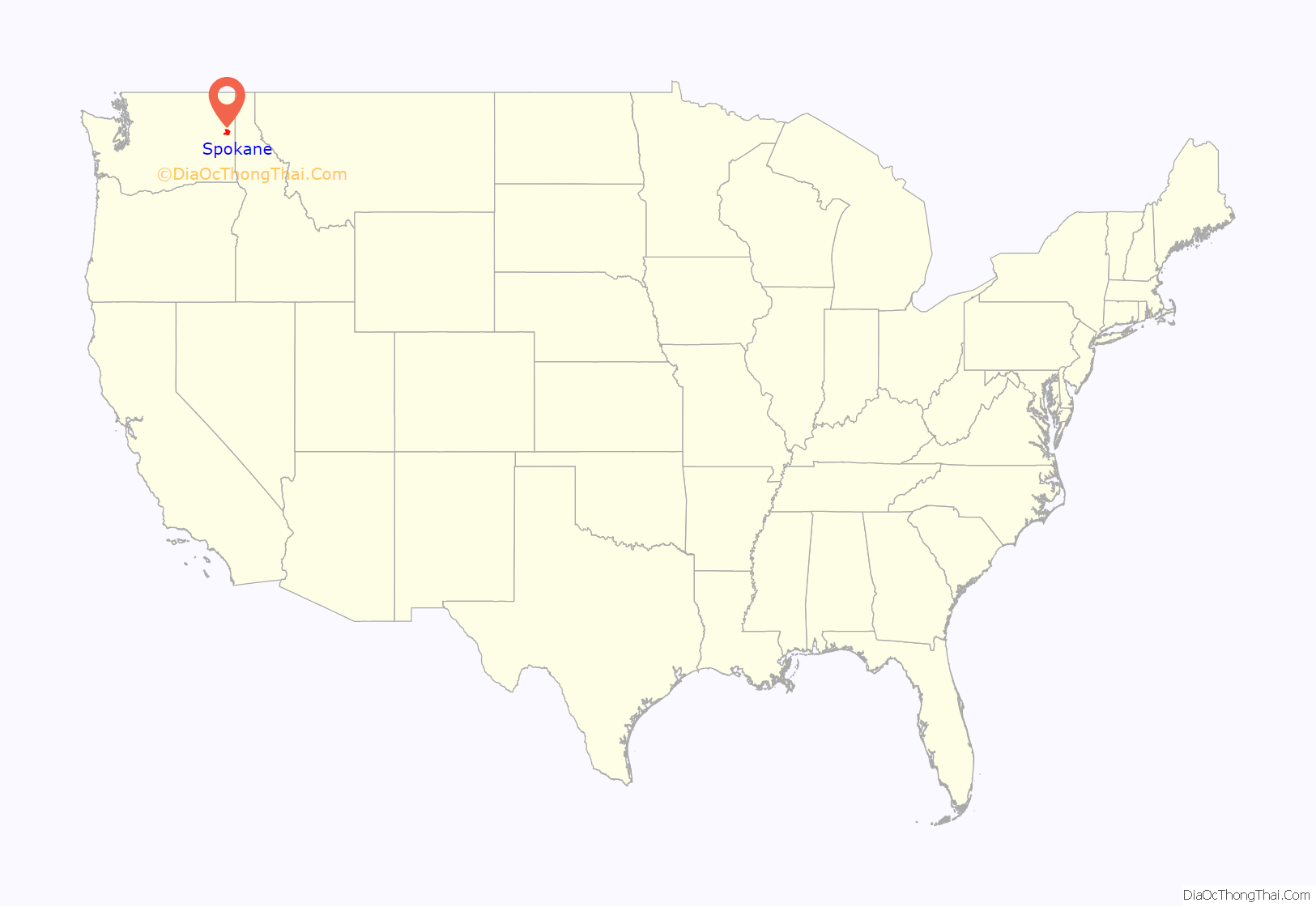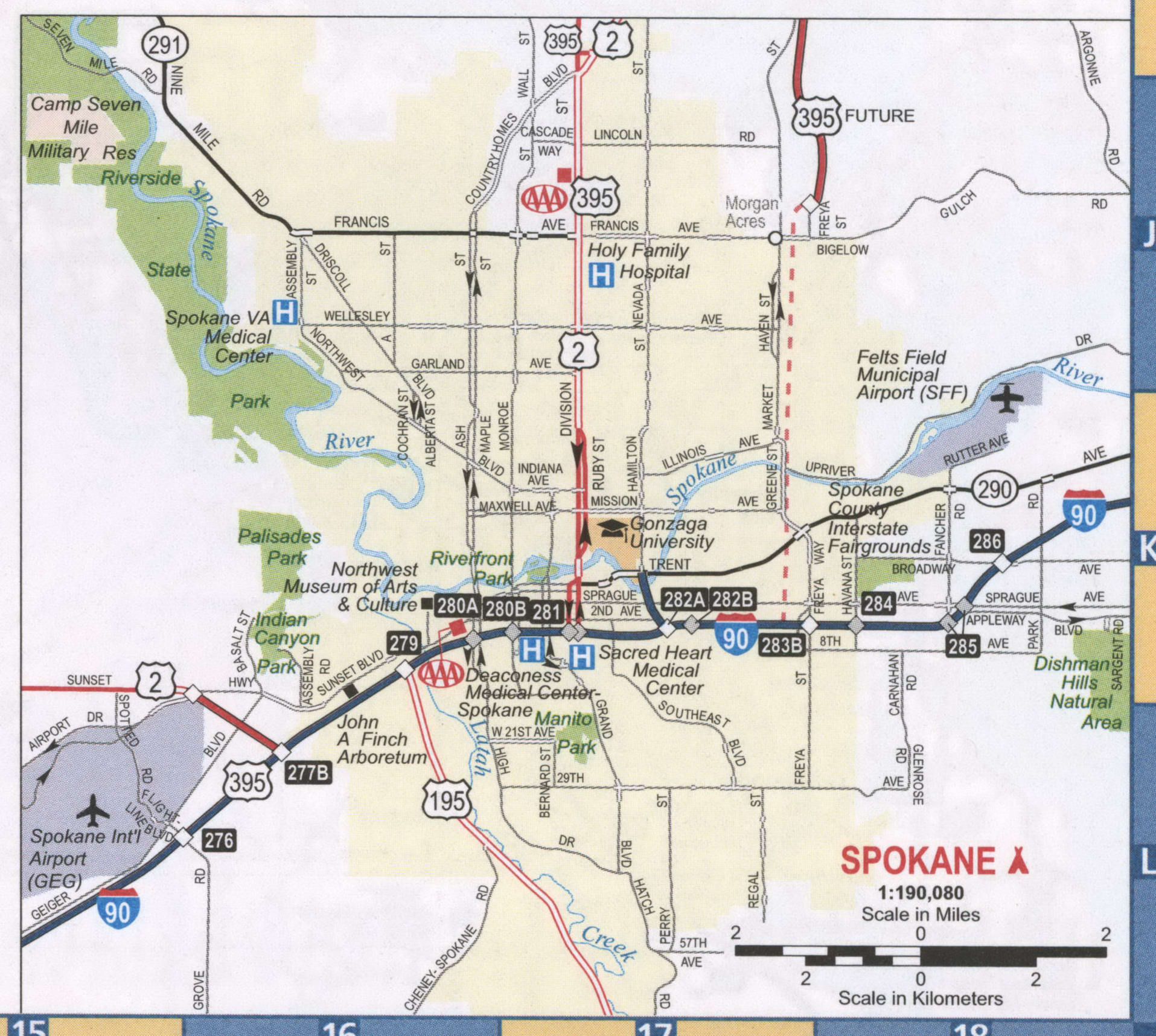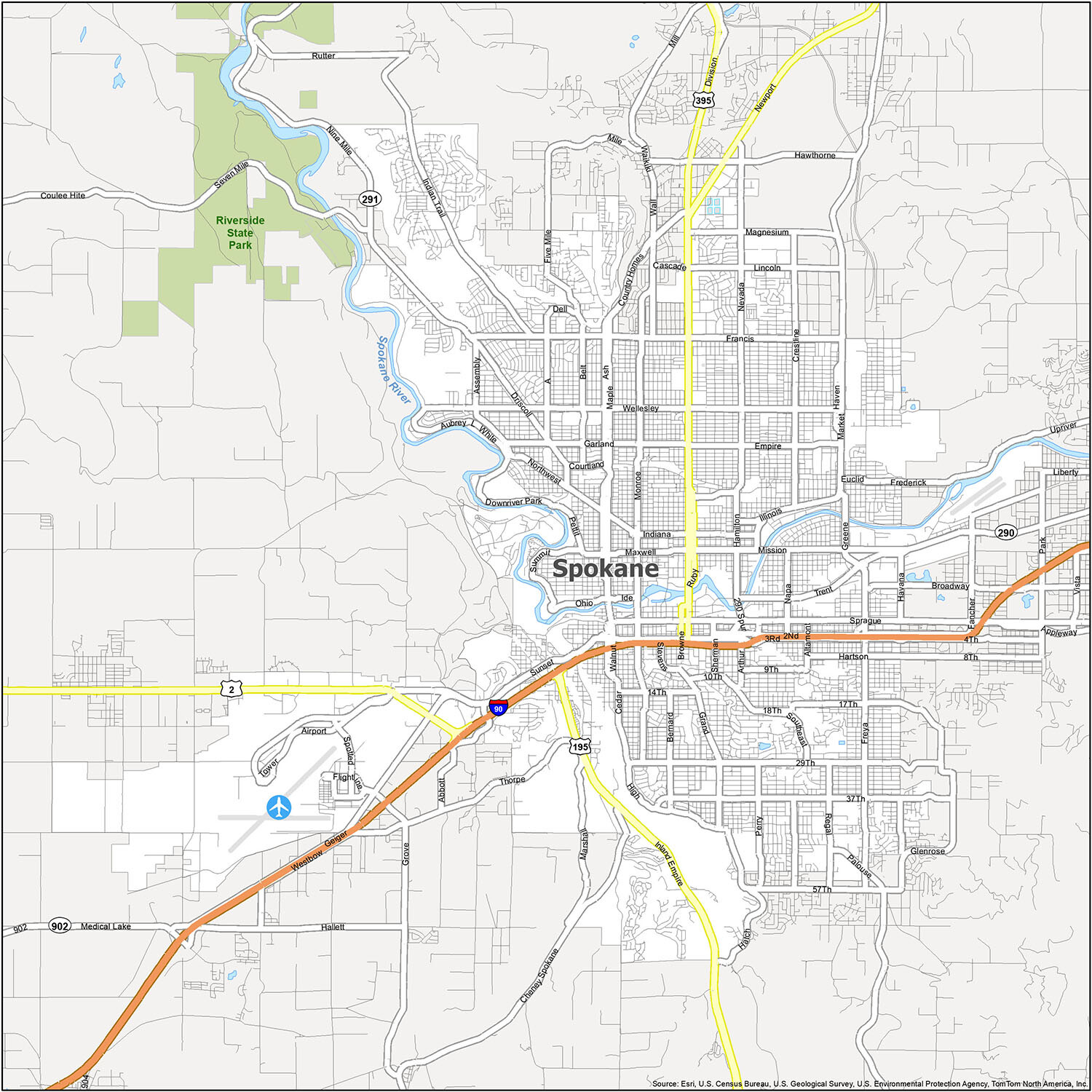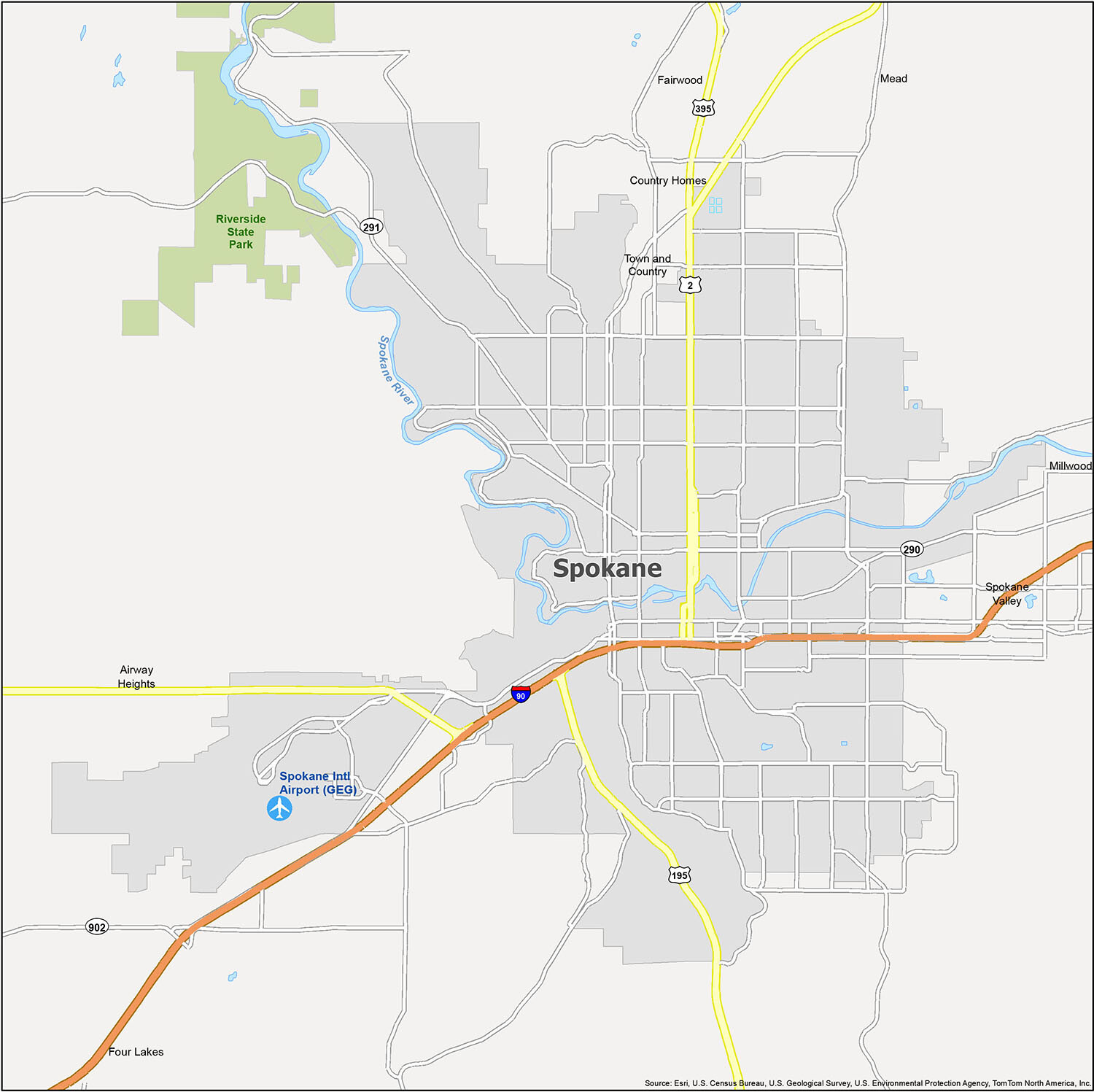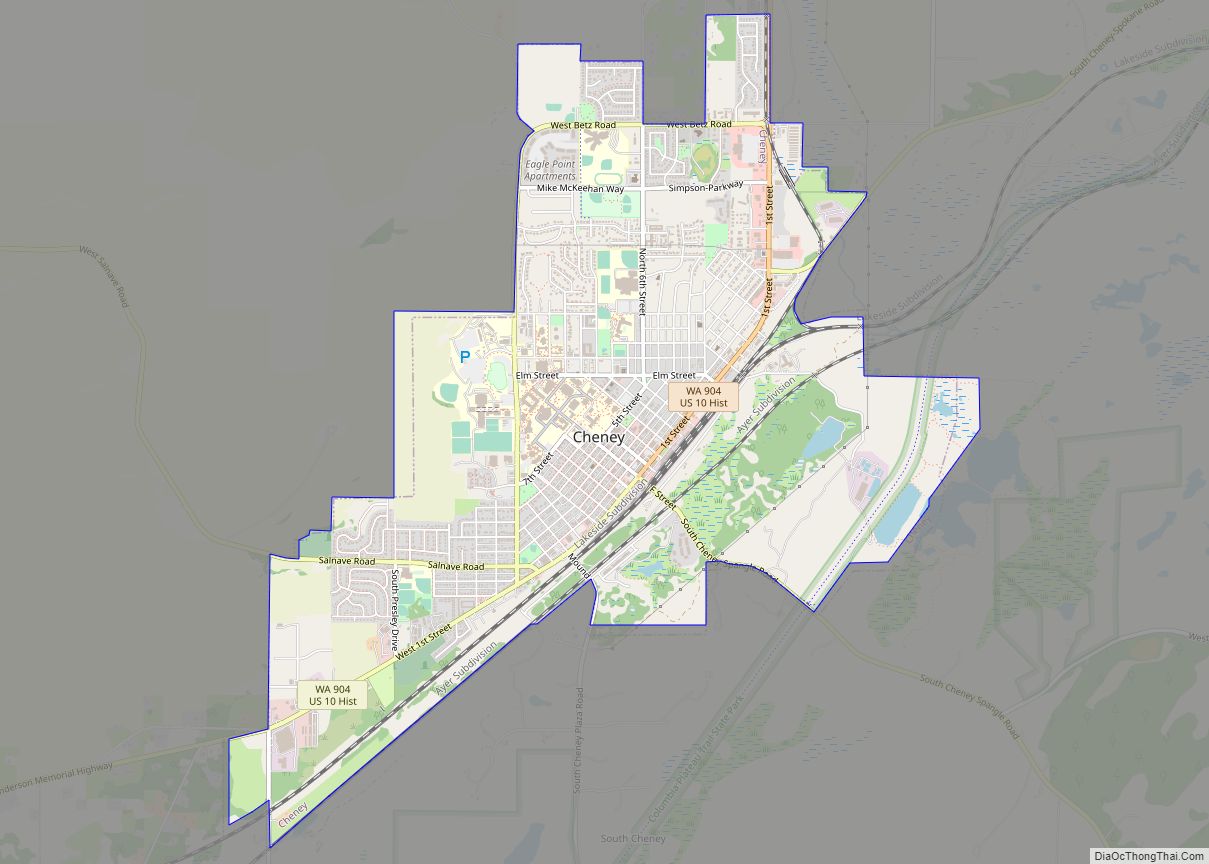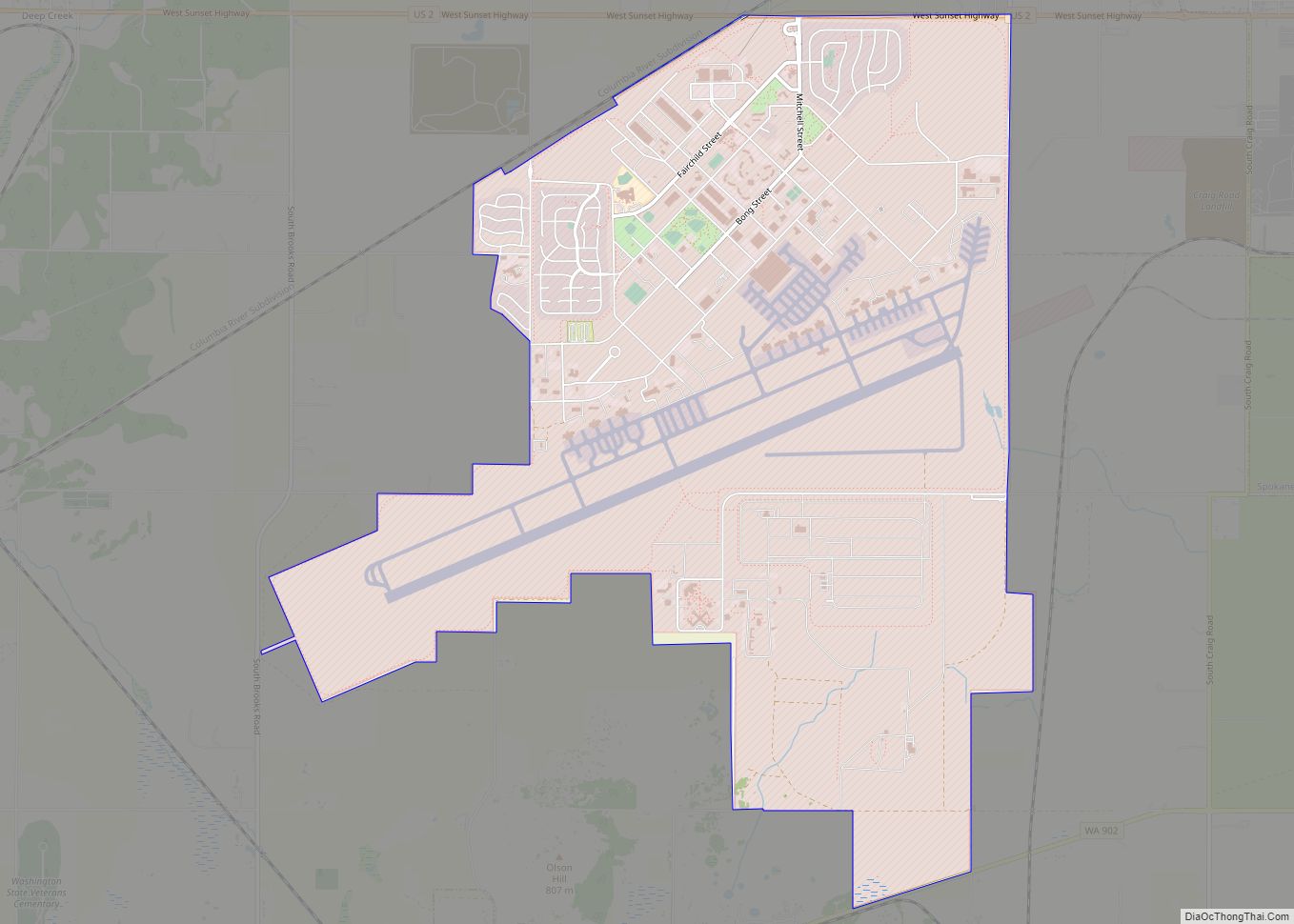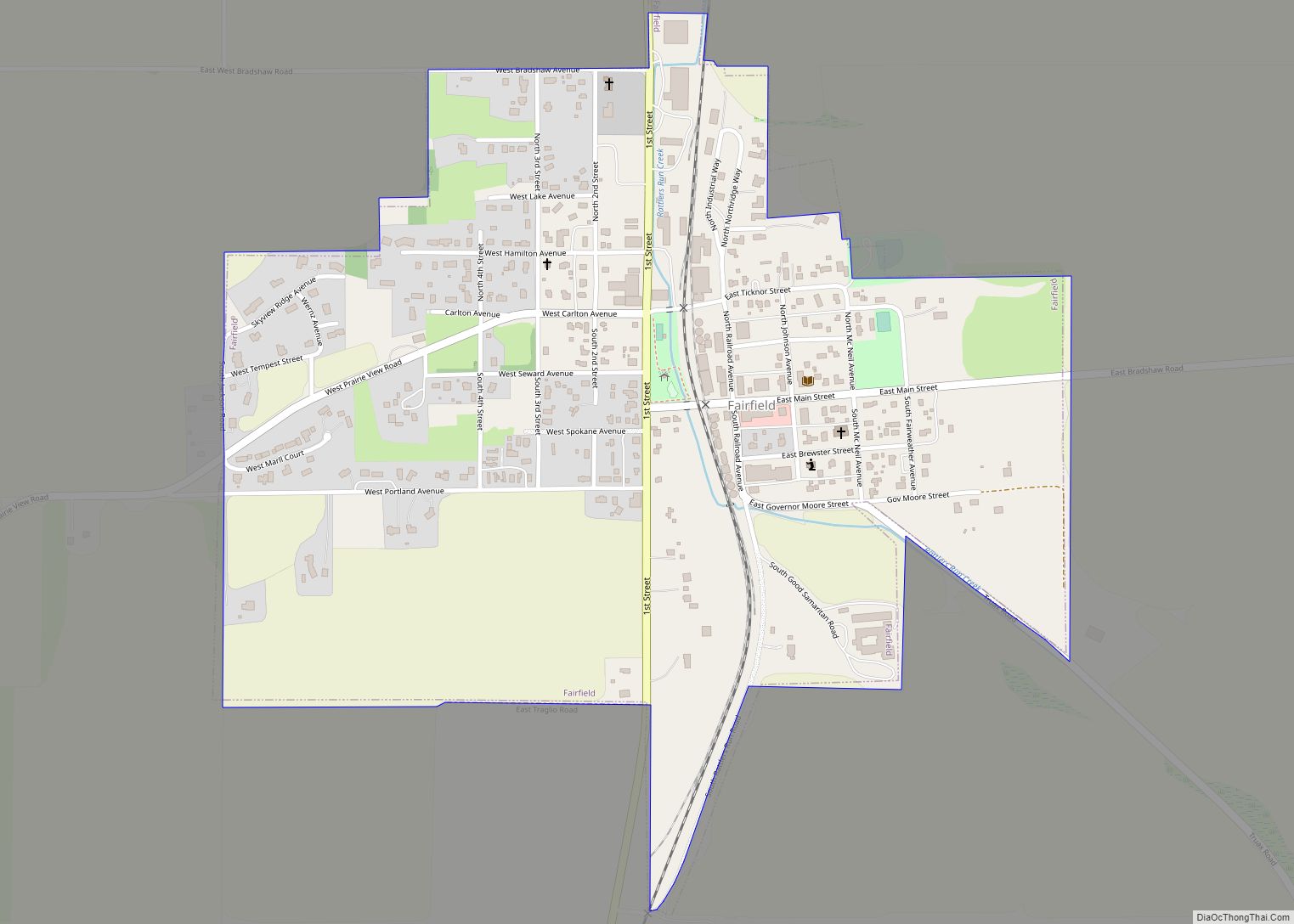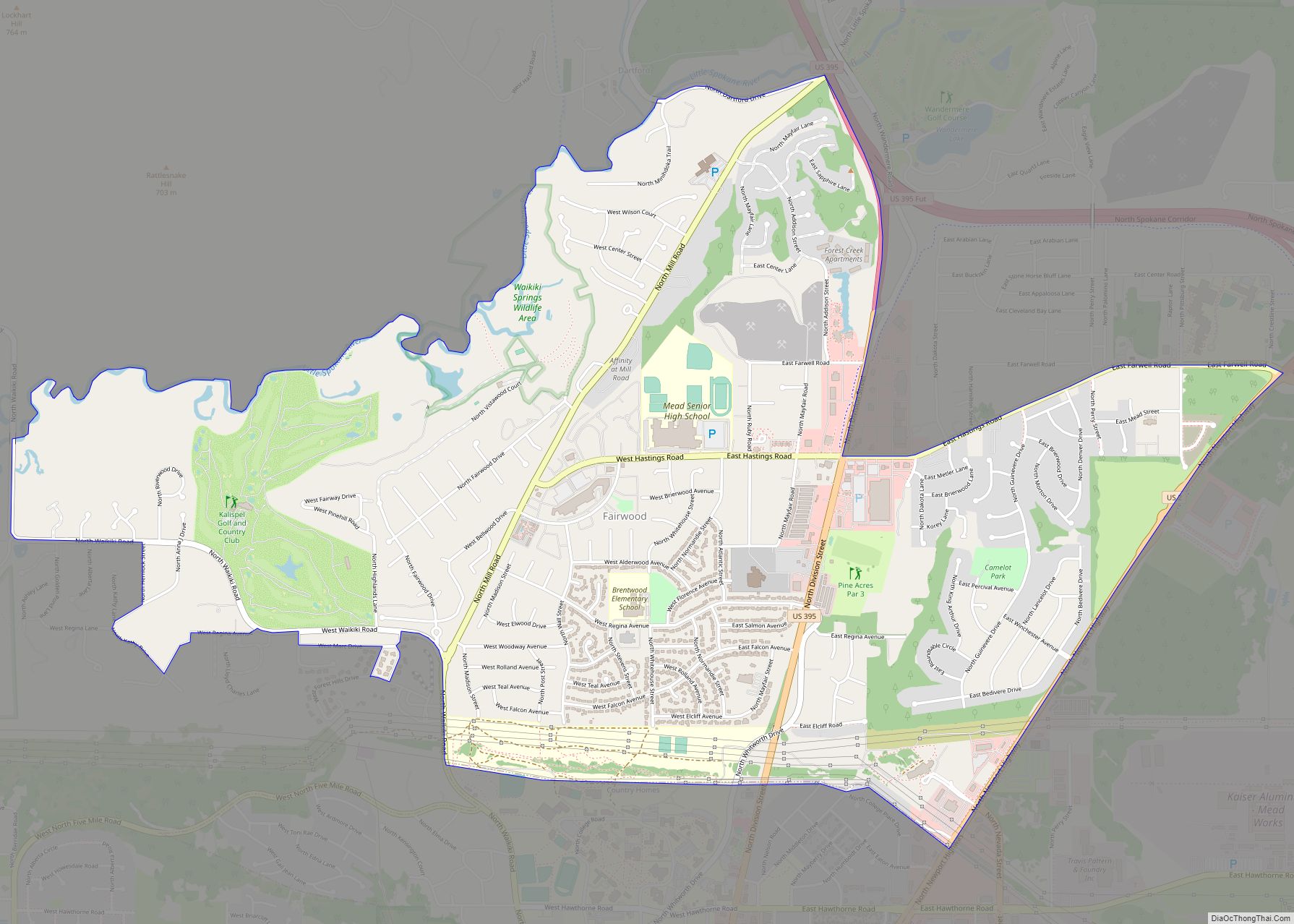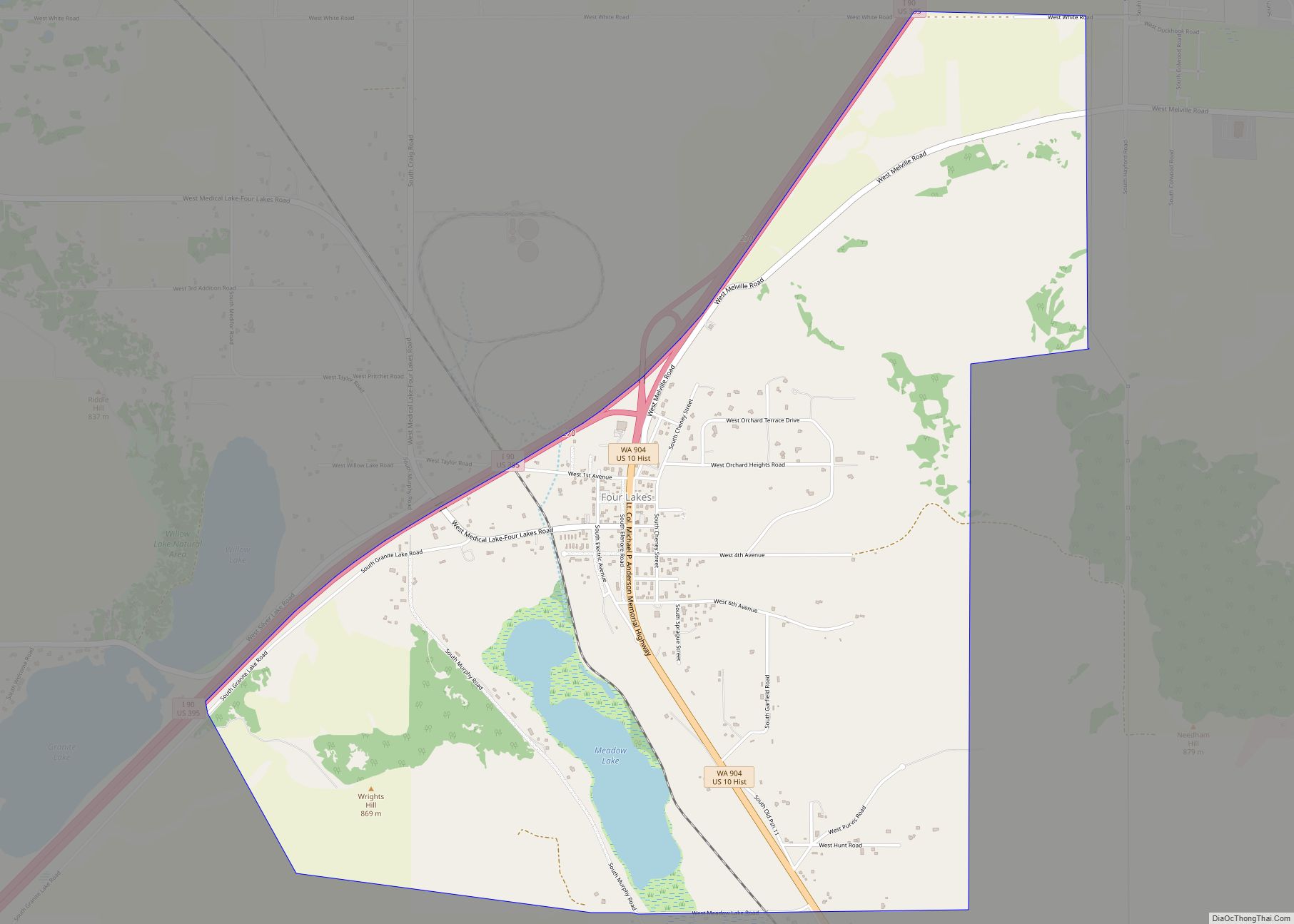Spokane (/spoʊˈkæn/ (listen) spoh-KAN) is the largest city and county seat of Spokane County, Washington, United States. It is in eastern Washington, along the Spokane River, adjacent to the Selkirk Mountains, and west of the Rocky Mountain foothills, 92 miles (148 km) south of the Canadian border, 18 miles (30 km) west of the Washington–Idaho border, and 279 miles (449 km) east of Seattle, along I-90.
Spokane is the economic and cultural center of the Spokane metropolitan area, the Spokane–Coeur d’Alene combined statistical area, and the Inland Northwest. It is known as the birthplace of Father’s Day, and locally by the nickname of “Lilac City”. Officially, Spokane goes by the nickname of Hooptown USA, due to Spokane annually hosting Spokane Hoopfest, the world’s largest basketball tournament. The city and the wider Inland Northwest area are served by Spokane International Airport, 5 miles (8 km) west of Downtown Spokane. According to the 2010 census, Spokane had a population of 208,916, making it the second-largest city in Washington, and the 101st-largest city in the United States. At the 2020 census, Spokane’s population was 228,989. A 2021 estimate sets the population of the Spokane Metropolitan Area at 593,466.
The first people to live in the area, the Spokane tribe (their name meaning “children of the sun” in Salishan), lived off plentiful game. David Thompson explored the area with the westward expansion and establishment of the North West Company’s Spokane House in 1810. This trading post was the first long-term European settlement in Washington. Completion of the Northern Pacific Railway in 1881 brought settlers to the Spokane area. The same year it was officially incorporated as a city under the name of Spokane Falls (it was re-incorporated under its current name ten years later). In the late 19th century, gold and silver were discovered in the Inland Northwest. The local economy depended on mining, timber, and agriculture until the 1980s. Spokane hosted the first environmentally themed World’s fair at Expo ’74.
Many of the downtown area’s older Romanesque Revival-style buildings were designed by architect Kirtland Kelsey Cutter after the Great Fire of 1889. The city is also home to the Riverfront and Manito parks, the Smithsonian-affiliated Northwest Museum of Arts and Culture, the Davenport Hotel, and the Fox and Bing Crosby theaters.
The Cathedral of Our Lady of Lourdes is the seat of the Roman Catholic Diocese of Spokane, and the Cathedral of St. John the Evangelist serves as that of the Episcopal Diocese of Spokane. The Spokane Washington Temple in the east of the county serves the Church of Jesus Christ of Latter-day Saints. Gonzaga University was established in 1887 by the Jesuits, and the private Presbyterian Whitworth University was founded three years later and moved to north Spokane in 1914.
The city’s western suburb of Airway Heights is home to Fairchild Air Force Base as well as two large casino hotels.
In sports, the region’s professional and semi-professional sports teams include the Spokane Indians in Minor League Baseball and Spokane Chiefs in junior ice hockey. The Gonzaga Bulldogs collegiate basketball team competes at the Division I level. As of 2010, Spokane’s major daily newspaper, The Spokesman-Review, had a daily circulation of over 76,000.
| Name: | Spokane city |
|---|---|
| LSAD Code: | 25 |
| LSAD Description: | city (suffix) |
| State: | Washington |
| County: | Spokane County |
| Founded: | 1873 |
| Incorporated: | November 29, 1881 |
| Elevation: | 1,843 ft (562 m) |
| Land Area: | 68.76 sq mi (178.09 km²) |
| Water Area: | 0.74 sq mi (1.91 km²) 1.28% |
| Population Density: | 3,300/sq mi (1,300/km²) |
| Area code: | 509 |
| FIPS code: | 5367000 |
| GNISfeature ID: | 1512683 |
| Website: | my.spokanecity.org |
Whether you’re in Spokane for a few days or a few weeks, our maps of Spokane are your perfect companion to help you explore the city. Our interactive map includes highways, roads, points of interest, and more. Plus, our collection of Spokane maps includes an interactive map to help you get around the city with ease.
So, if you’re looking for a map of Spokane, Washington, you’ve come to the right place. Our collection of maps has everything you need like highways, roads, points of interest, and an interactive map to help you explore the city.
Explore Spokane with Our Maps
Are you looking for a map of Spokane, Washington? Look no further. Our collection of maps has everything you need to explore the city like highways, roads, things to do, and an interactive map. From its historic buildings to its natural beauty like the Upper Spokane Falls, this growing community offers visitors an amazing amount to see and do.
The Spokane map collection is free to use so you can start navigating around the city of Spokane today. Whether you’re in Spokane for a few days or a few weeks, our maps of Spokane are your perfect companion to help you explore the city. Our interactive map includes highways, roads, points of interest, and more.
So, if you’re ready to explore the city of Spokane, Washington, our collection of maps has everything you need. Start navigating around the city today with our free Spokane map collection.
Online Interactive Map
Click on ![]() to view map in "full screen" mode.
to view map in "full screen" mode.
This Spokane Washington interactive map is a fun and immersive way to explore the city. With the latest updated information, this map shows you everything from hotels and restaurants to historical landmarks. The map is easy to use and is perfect for exploring the city on your own.
Spokane location map. Where is Spokane city?
Spokane Road Map
Do you ever feel lost when trying to find your way around Spokane? This interactive map is the perfect tool for anyone who wants to know their way around town. It will help you navigate your way around the city, showing you the interstates like I-90, state highways, and major roads. If you want to get out of the city, then check out the Washington road map for more details on highways in the state.
The reference map of the city of Spokane is a great source of information for anyone looking to explore this beautiful city. With an overview of the city’s natural areas, populated places, airports, cities, census-designated places, parks and recreation, and rivers and lakes, the map is the perfect way to plan your next trip to Spokane. From Airway Heights and Millwood to Spokane and Spokane Valley, and from Country Homes and Fairwood to Four Lakes and Mead, the map provides all the information you need to make your trip a success.
10 things to do in Spokane city
Spokane is a great place to explore and discover. Whether you’re looking for outdoor recreation, cultural attractions, or a fun night out, Spokane has something for everyone. With this map, you can start your adventure in Spokane and find all the best places to visit in the city.
Spokane is a great place to live, work, and explore. With so many activities to choose from, it can be hard to know where to start. This map will help you discover the top attractions in Spokane, from downtown to its museums and parks. With this guide, you can easily get started on your adventure and find the best things to do in the city.
Spokane city Satellite Map
Geography
Topography
Spokane is located on the Spokane River in eastern Washington at an elevation of 1,843 feet (562 m) above sea level, about 18 miles (29 km) from Idaho, 92 miles (148 km) south of the Canadian border, 229 miles (369 km) due east of Seattle, and 279 miles (449 km) southwest of Calgary. The lowest elevation in the city of Spokane is the northernmost point of the Spokane River within city limits (in Riverside State Park) at 1,608 feet (490 m); the highest elevation is on the northeast side, near the community of Hillyard (though closer to Beacon Hill and the North Hill Reservoir) at 2,591 feet (790 m). Spokane is part of the Inland Northwest region, consisting of eastern Washington, north Idaho, northwestern Montana, and northeastern Oregon. The city has a total area of 60.02 square miles (155.45 km), of which 59.25 square miles (153.46 km) is land and 0.77 square miles (1.99 km) is water.
Spokane lies mostly within the Spokane Valley Outwash Plains at the periphery of the North Central Rockies forests ecoregion and partly within the eastern edge of the basaltic Channeled Scablands steppe of the Columbia Plateau ecoregion, a plain that eventually rises sharply to the east towards the rugged, timbered Selkirk Mountains. The foothills of the Rockies—the Coeur d’Alene Mountains—rise about 25 miles (40 km) to the east in north Idaho. The city is in a transition area between the barren landscape of the Columbia Basin and the coniferous forests to the east; to the south are the lush prairies and rolling hills of the Palouse. The highest peak in Spokane County is Mount Spokane, at an elevation of 5,883 feet (1,793 m), on the eastern side of the Selkirk Mountains. The Spokane River is the area’s most prominent water feature, a 111-mile (179 km) tributary of the Columbia River, originating from Lake Coeur d’Alene in northern Idaho. The river flows west across the Washington state line through downtown Spokane, meeting Latah Creek, then turns to the northwest, where it is joined by the Little Spokane River on its way to the Columbia River, north of Davenport. The Channeled Scablands and many of the area’s numerous large lakes, such as Lake Coeur d’Alene and Lake Pend Oreille, were formed by the Missoula Floods after the ice-dammed Glacial Lake Missoula ruptured at the end of the last ice age. The Turnbull National Wildlife Refuge south of Cheney is the closest natural reserve, the closest National Forest is the Colville National Forest, the closest National Recreation Area is the Lake Roosevelt National Recreation Area and the closest national park is Mount Rainier National Park, approximately a four-and-a-half hour drive from Spokane.
Flora and fauna
The area supports an abundance of wildlife in part because of its varied geology and natural history. The area contains a wide range of vegetation, from densely wooded coniferous forests to rolling grassy hills and meadows. Ponderosa pine and Douglas fir are common in the drier and lower elevation areas throughout the region. The ponderosa pine is the official tree of the City of Spokane, which is where specimens were first collected by botanist David Douglas in 1826.
The Canadian Rockies ecoregion supports 70 mammals, 16 reptiles and amphibians, 168 birds, and 41 fish species. There is a high concentration of raptors in the area, bald eagles are a common sight near Lake Coeur d’Alene in December and January when kokanee spawn. The most common fish present in area lakes is the Washington-native rainbow trout, which is the official fish of Washington state. Big game common in eastern Washington include black and grizzly bears, caribou, Rocky Mountain elk, bighorn sheep, and cougar. Whitetail deer, mule deer, and moose are also found in abundance. The gray wolf population has been making a recovery in the Inland Northwest. As of June 2016, there are 16 wolf packs in eastern Washington. In August 2016, photo evidence confirmed a solitary wolf in Mount Spokane State Park.
Although the ecoregion remains ecologically intact, it faces conservation challenges that include the negative effects of certain forestry management and logging practices, higher risks of forest fires due to the alteration of the trees that make up the forest composition, and habitat fragmentation as a result of urban sprawl and development, which endangers the long-term survival of vulnerable species such as mountain caribou and the Northern goshawk.
Climate
Spokane has a warm-summer humid continental climate (Dsb under the Köppen classification), a rare climate due to its elevation and significant winter precipitation; Spokane, however, is adjacent to and sometimes even classified as a warm-summer Mediterranean climate (Csb) because the average temperature for the coldest month is over 26.6 °F (−3 °C), though in the US this threshold is often defined to be 32 °F (0 °C).
The area typically has a warm, arid climate during the summer months, bracketed by short spring and fall seasons. On average, the warmest month is July and the coolest month is December; July averages 71.0 °F (21.7 °C), while December averages 29.1 °F (−1.6 °C). Daily temperature ranges are large during the summer, often exceeding 30 °F (17 °C), and small during the winter, with a range just above 10 °F (5.6 °C). The record high and low are 112 °F (44 °C) and −30 °F (−34 °C), but temperatures of more than 100 °F (38 °C) or less than −5 °F (−21 °C) are rare. Temperatures of 90 °F (32 °C)+ occur an average of 21 days annually, temperatures of 100 °F (38 °C)+ occur an average of only 1 day annually, and those at or below 0 °F (−18 °C) average 2.2 days a year.
Spokane’s location, between the Cascades Range to the west and the Rocky Mountains to the east and north, protects it from weather patterns experienced in other parts of the Pacific Northwest. The Cascade Mountains form a barrier to the eastward flow of moist and relatively mild air from the Pacific Ocean in winter and cool air in summer. As a result of the rain shadow effect of the Cascades, the Spokane area has 16.5 inches (420 mm) average annual precipitation, less than half of Seattle’s 39.3 inches (1,000 mm). Precipitation peaks in December, and summer is the driest time of the year. The Rockies shield Spokane from some of the winter season’s coldest air masses traveling southward across Canada.
See also
Map of Washington State and its subdivision:- Adams
- Asotin
- Benton
- Chelan
- Clallam
- Clark
- Columbia
- Cowlitz
- Douglas
- Ferry
- Franklin
- Garfield
- Grant
- Grays Harbor
- Island
- Jefferson
- King
- Kitsap
- Kittitas
- Klickitat
- Lewis
- Lincoln
- Mason
- Okanogan
- Pacific
- Pend Oreille
- Pierce
- San Juan
- Skagit
- Skamania
- Snohomish
- Spokane
- Stevens
- Thurston
- Wahkiakum
- Walla Walla
- Whatcom
- Whitman
- Yakima
- Alabama
- Alaska
- Arizona
- Arkansas
- California
- Colorado
- Connecticut
- Delaware
- District of Columbia
- Florida
- Georgia
- Hawaii
- Idaho
- Illinois
- Indiana
- Iowa
- Kansas
- Kentucky
- Louisiana
- Maine
- Maryland
- Massachusetts
- Michigan
- Minnesota
- Mississippi
- Missouri
- Montana
- Nebraska
- Nevada
- New Hampshire
- New Jersey
- New Mexico
- New York
- North Carolina
- North Dakota
- Ohio
- Oklahoma
- Oregon
- Pennsylvania
- Rhode Island
- South Carolina
- South Dakota
- Tennessee
- Texas
- Utah
- Vermont
- Virginia
- Washington
- West Virginia
- Wisconsin
- Wyoming
